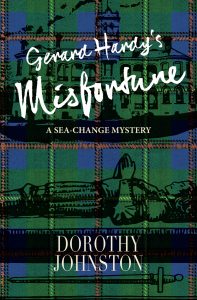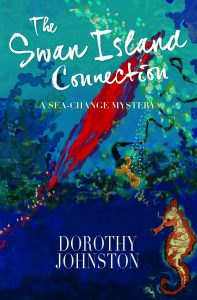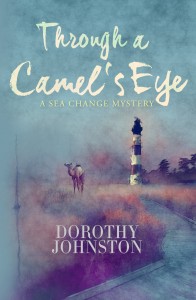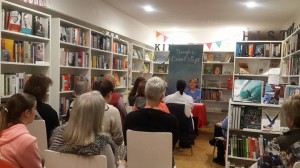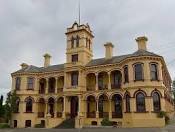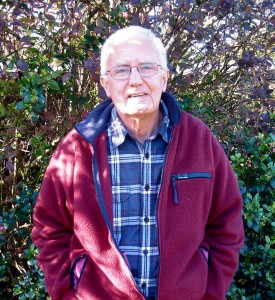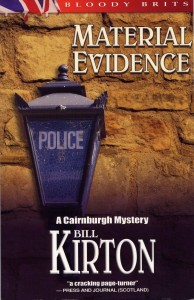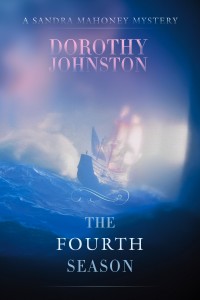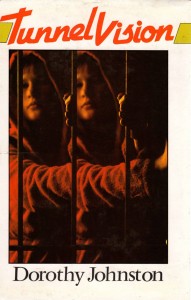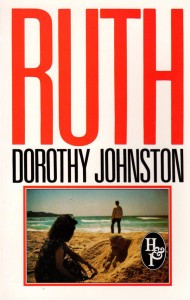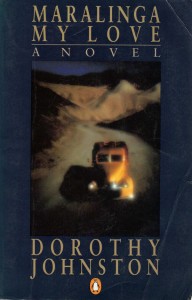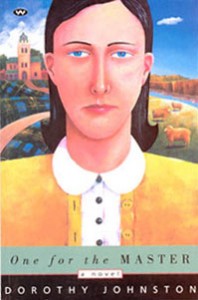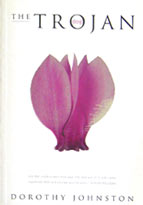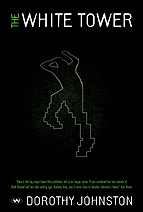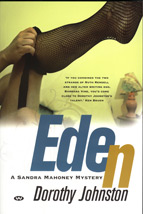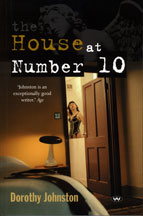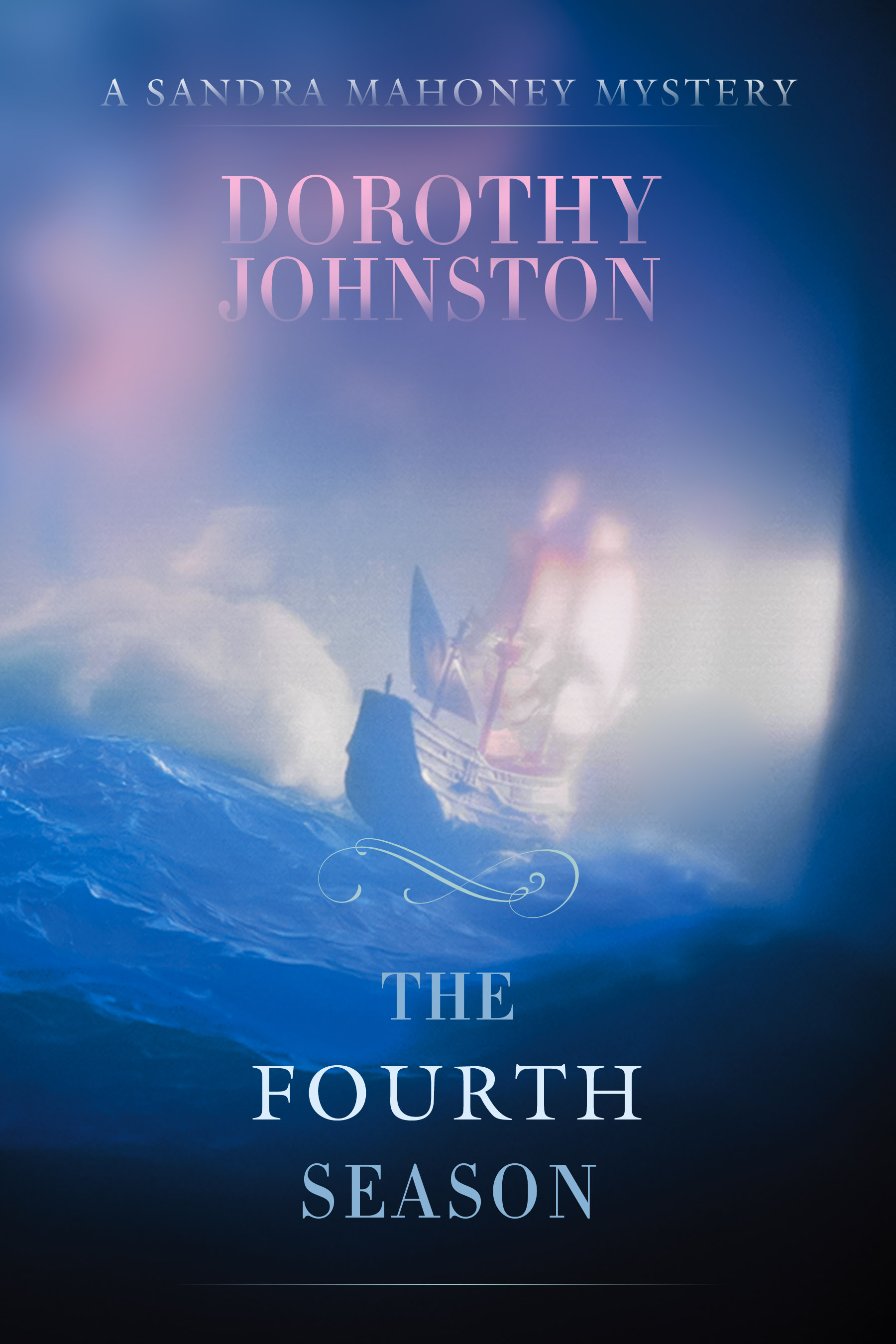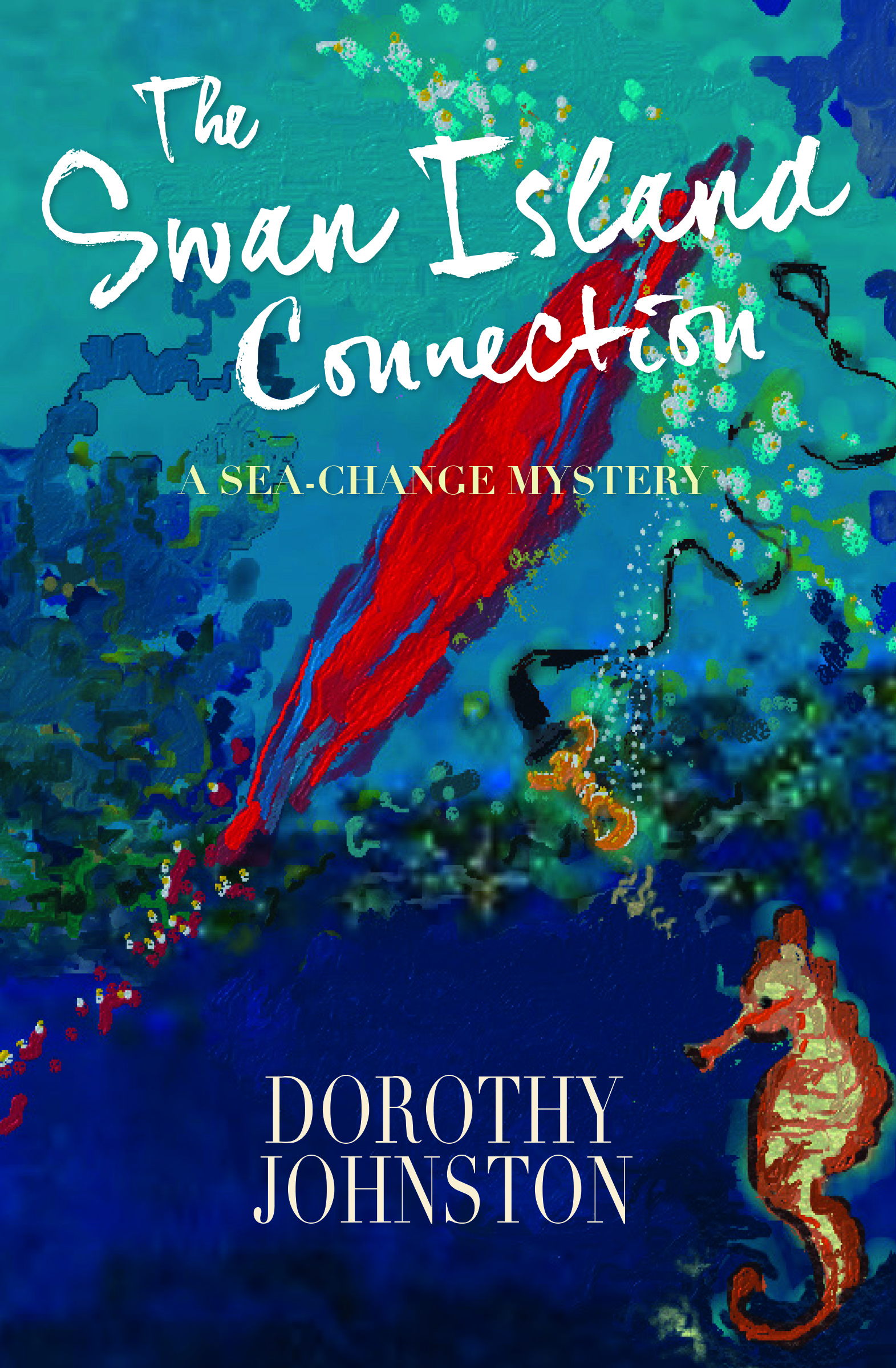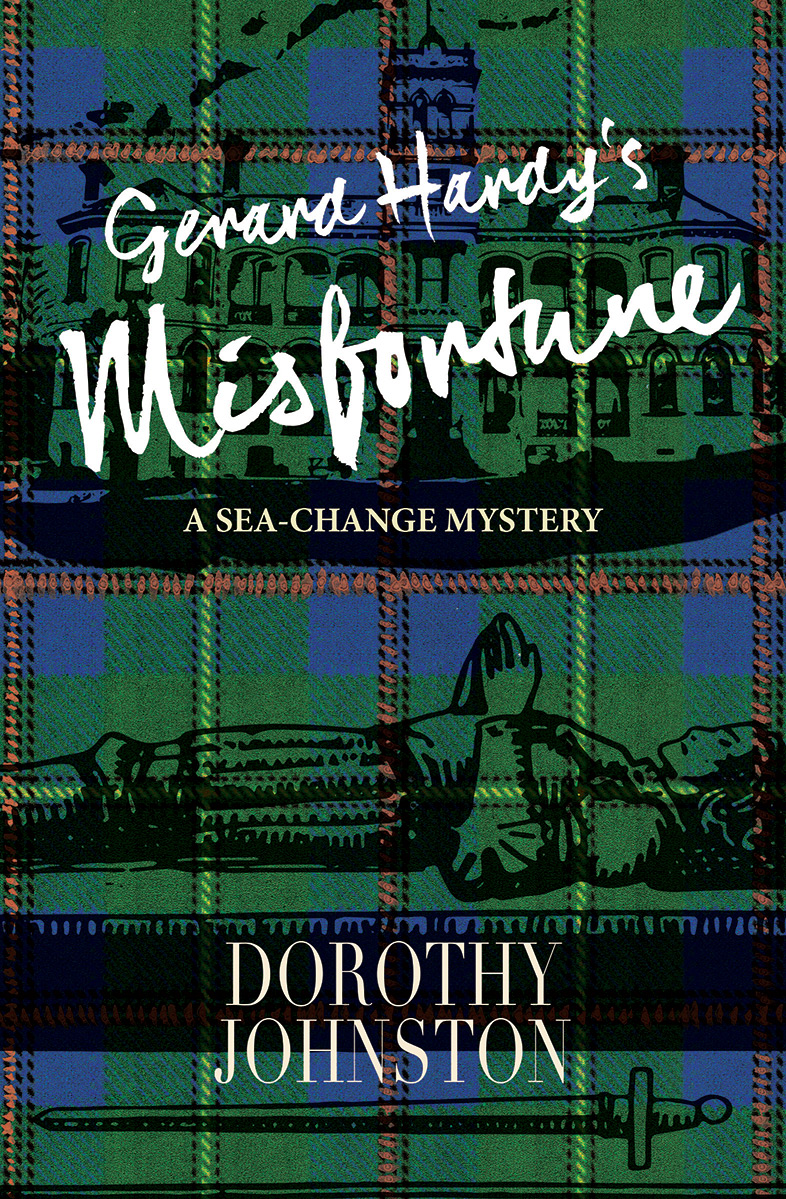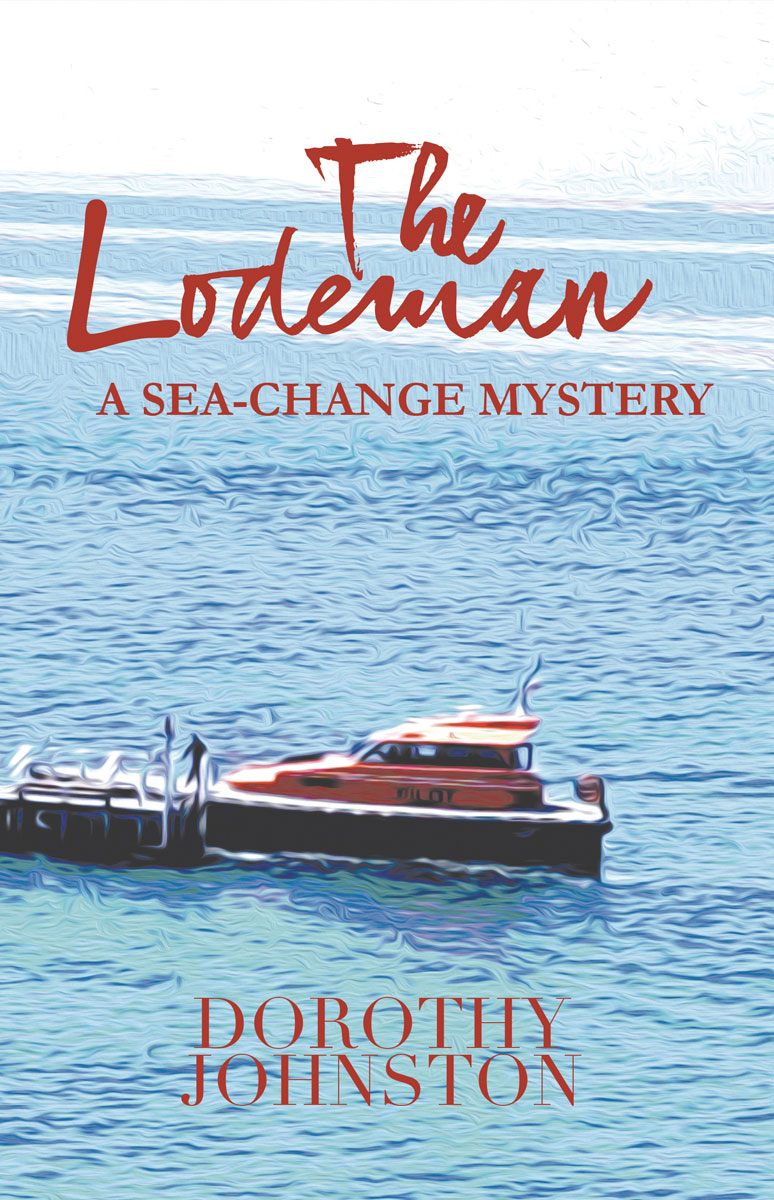Well, the countdown has begun in earnest now, to the publication of my third sea-change mystery and twelfth novel, Gerard Hardy’s Misfortune.
A few days ago, I was asked what clan tartan the cover designer, John Cozzi, had used.
It’s a hybrid, based on the Johnston, my family’s tartan on my father’s side, but with brown lines added. Those lines, and the pale green ones as well, suggest bars on a cell to me, and will perhaps to others too, when they read the story. My murder victim, Gerard Hardy, is found in a cell-like room at the end of a basement corridor, underneath Queenscliff’s historic Royal hotel.
The title is a play on The Fortunes of Richard Mahony and Hardy is a Henry Handel Richardson scholar, in Queenscliff to conduct some unorthodox research.
As I’ve said in previous posts, I find Richardson’s a compelling presence still, just up the hill from the Royal, at 26 Mercer Street, where she lived as a small girl with her mother and father and her sister, Lil.
Gerard Hardy’s Misfortune isn’t an historical novel, but the history of the Richardson family does play an important part.
And the glue that holds the whole thing together is provided by the main characters in my first two sea-change mysteries, Chris Blackie and Anthea Merritt.
Some time back I wrote a post on ghosts at the Royal Hotel in Queenscliff.
At last the long process of writing and editing my novel about a murder in the basement of the Royal is coming to an end. I’m involved in discussions about the cover, which will be designed by the incomparable John Cozzi, who created the cover for the second book in my sea-change mystery series, The Swan Island Connection. I’ve just sent John some photos of the haunted old hotel.
Reading through my manuscript for the last time, I was surprised by the importance of ghosts. That sometimes happens to a fiction writer; she’s busy focussing on one theme or another, then goes back to the story and finds that something else has been important all along.
Brigid Magner is a literary scholar and lecturer at RMIT. Speaking about her research on literary tourism, Brigid makes the point that houses where famous writers have lived are often felt to be haunted.
“But the term ‘haunted’ does not always refer to ghosts as such. It can also refer to a ‘haunted’ state which can either be a pleasant communion with a bygone spirit, or it might entail distress and anxiety. It can also refer to the old ‘haunts’ of notable individuals.”
In my story, the young man killed in the Royal’s basement was a Henry Handel Richardson scholar, visiting Queenscliff for a tarot reading which he hoped would connect him to the spirit of his heroine.
In the 1870s, the child who was to become Henry Handel Richardson lived with her family at 26 Mercer Street, just a hop, step and jump from the Royal. No one has seen or heard or felt a ghost at 26 Mercer Street so far as I’m aware, but the Royal is reputed to be haunted from its basement to the top of its tower. Built in the 1850s, it was Queenscliff’s first morgue.
Ethel Richardson – or Ettie as she was known when she was a small girl – believed the spirits of the dead could communicate with living human beings, as did her father, Walter and her sister Lil. Ethel maintained this belief to the end of her life, though she was secretive about it.
I thought of all of this as background to a murder mystery, but then somehow it became more than background. Not that my main characters believe in ghosts or spirits; they don’t. But they are influenced by them nonetheless.
One suspect sees visions and has done since her childhood. Chris, my police constable, is sympathetic, but wary at the same time. Then one night he ‘sees’ Mary Richardson, Ethel’s mother, hurrying home from the fort where she has been struggling to learn book-keeping and Morse code so she can support her daughters.
Chris, who has always admired Mary, is moved and shocked.
I guess is that, looking back at the novel now that it is finished, I realise there’s a thin membrane, a kind of gauzy veil, separating my policeman and woman from the characters they are investigating. There aren’t two sides of the fence; there’s no black and white. This blurring of boundaries interests me. I hope it will interest readers too.
The Swan Island Connection, the second of my sea-change mysteries, will be launched in Queenscliff, Victoria, in October. Thanks to everyone who’s helped me get this far, and a special thanks to my publishers, For Pity Sake. It’s possible to order a copy from them now.
The Swan Island Connection features senior constable Chris Blackie, in charge of the small, some would say redundant Queenscliff police station. Anthea Merritt is his young assistant, trained in Melbourne and reluctant to bury herself in a coastal town.
The plot revolves around the secret training base on Swan Island, close to Queenscliff, and the connection between soldiers training at the base, the local police and CIU, and an investigation into the death of a ten-year-old boy.
Though the existence of a training base on Swan Island was denied for years by successive federal governments, Brian Toohey and Bill Pinwell, in their book Oyster: the story of the Australian Secret Intelligence Service offer some tantalising details.
‘(On Swan Island) the eager young army officers and NCOs learnt the dark arts of demolition, disguise, deception, sabotage, secret communication, and assassination… In one exercise on Swan Island the incorrect line of fire was set on a Chinese medium machine gun so that tracer bullets shot over the sandhills into the rigging of fishing boats in Port Phillip Bay. Fortunately for ASIS the only complaint made to the media was about the noise…’
There’s a special kind of snail that lives in the seagrass of Swan Bay. Because the bay is so shallow, it’s an important fish nursery and the baby fish eat the snails. Marine scientists didn’t know why the snail numbers were decreasing. They did a study and found that the lead in the bullets has been turning all the snails into males. I don’t know the end result of this, but I’d hope that those organising target practice would find other, safer ways than firing into the water.
Local legends date from the time when regular army personnel were allowed to have their families living with them on the island. One woman recalls a birthday when she was a small girl, how she and her friends had gone for a walk in their party dresses and come upon a soldier in full combat gear lying in the marram grass. Another incident involved a night-time exercise, with trainees climbed across roofs and one inadvertently jumping down onto the family dog.
Part of the island is occupied by a golf club and my favourite story is about my mother and a group of critically endangered orange-bellied parrots.
Each winter the parrots used to fly across to Swan Island from Tasmania and my mother, a keen environmentalist and bird-lover, used to observe and record them. Sadly, there haven’t been any for the past few years. My mother was allowed permission to enter the golf club part of the island. One day, engrossed in her task, she didn’t realise that the birds had ventured into the forbidden zone. Following them, she was shocked by a loud voice bellowing ‘Stop!’ and three soldiers in combat gear running through the bushes. Mum was a small woman, though by no means a cowardly one. She stood still, clutching her clipboard to her chest, and explained politely that she was tracking the parrots who couldn’t read the Keep Out signs.
On October 7, eight female crime and mystery writers will converge on Cobargo, just inland from Bermagui on the NSW coast, to take part in their inaugural crime convention.
http://fourwinds.com.au/whats-on/sisters-in-crime/
The writers are an eclectic mix, from a gynaecologist living in far north Queensland, Caroline de Costa, to a former member of the RAAF, who also has a BA in medieval history, Ilsa Evans, to a writer of historical crime (Sydney/1930s), Sulari Gentill, to yours truly, author of a Canberra-based quartet, now embarked on a sea-change mystery series.
One of the festival organisers, in a welcoming email, said that they were washing the streets of Cobargo in honour of our arrival. Thank you, Louise!
While this is an attractive idea, I wonder if it really fits a collection of crime writers, who might be more comfortable with dirty streets, even blood-stained ones?
Jennifer Rowe once referred to crime writers as ‘good housekeepers’, by which she meant that we like to tidy things up, which has an element of truth in it, at least for some exponents of the genre. But even PD James said that order is never really re-established at the end of her novels.
My approach to clean streets is that I like to dig beneath them – hardly surprising since I lived in Canberra for 30 years and turned to mysteries as a way of writing about that city.
Now what exercises my imagination is what might lie beneath the surface of an idyllic coastal town….
Through a Camel’s Eye, the first of my sea-change mystery series, is now available as a paperback and ebook from the For Pity Sake website.
The ebook is also available on Amazon and other sites.
Thanks to all my friends who attended the launch in Queenscliff. It was an occasion to remember!
Joan Kerr, of Gert Loveday fame, has written a generous review of Through a Camel’s Eye which you can read here.
Thanks again to all the wonderful people who’ve helped me get this far. Through a Camel’s Eye is my tenth novel to be published. I’ve at last reached double figures -yeah! It really does feel like a milestone.
Last Friday (May 6) I gave an author talk at The Book Bird in West Geelong. Thanks to Anna, the bookshop proprietor, for hosting the event, and to everyone who came along!
When I read a description of The Three Princes of Serendip on Gert Loveday’s blog, I immediately felt anxious. Here was an ancient story that began with a missing camel. My new novel, Through a Camel’s Eye, due for release next year by Sydney-based publisher For Pity Sake, and up to the proof-reading stage, begins in exactly the same way. What if I had somehow, without remembering or realizing, absorbed the whole plot and transferred it to modern times, to the small town of Queenscliff close to where I live?
The camel in the old Persian tale is a native, as are the three young men who notice his tracks and cleverly deduce (in Sherlock Holmes fashion) all kinds of facts about him. My camel is an exotic and enchanting creature, at least he is to me. As I read on, I was relieved to find many other differences as well.
So I don’t have to face the ignominy of having pinched my plot. But the word ‘serendipity’, which Horace Walpole coined, using The Three Princes of Serendip as an example, is relevant to my story, and accurately conveys the way my protagonist goes about his detective work.
Chris Blackie, senior constable at the generally quiet Queenscliff police station, stumbles on an important clue while looking for camel tracks in the sandhills. His methods of deduction and inference, and those of his assistant, Anthea, fall well within the ‘serendip’ tradition. The clue discovered in the sandhills starts them off on the search for a missing woman.
‘..they were always making discoveries, by accidents and sagacity, of things which they were not in quest of..’ Walpole says, referring to the princes in a letter to Horace Mann.
Right!
I discovered that the Serendip (an old name for Sri Lanka) story is one of those that fairy-tale scholar Marina Warner describes as having ‘seven league boots’; that is, they can be found all over the world. In India, the tale involves an elephant, while in Palestine and Arabia it’s usually a camel that has disappeared. Walpole substitutes a mule, perhaps because mules were more familiar to him.
In cultures where tracking is not only an important, but an essential skill, it’s no surprise that such stories abound. I wish I could find an Aboriginal one to include here. Never mind, I’ll just keep looking and maybe…
I do admire the versatility of authors who straddle different modes of writing which, taken at face value, might seem to clash with one another. And I admire particularly, since this is my own weakness – strength? – those who produce both literary and crime fiction. Some, like George Johnston, did it to make money. Who remembers Johnston these days for the five detective novels he wrote under the pseudonym Shane Martin? Others write crime fiction as a collaborative effort, for example John Clanchy and Mark Henshaw. Still others split their writing selves into disparate parts, John Banville writing crime as Benjamin Black, for instance.
I wonder how they feel about it, whether it’s easy for them to put on a different hat. It’s not just easy for me; it’s delightful. I wonder whether choosing a playful pseudonym helps. (Shane was George Johnston’s sister and Martin his son.) I’ve never felt the need for a pen name, just as I’ve never felt the need to invent place names for my settings.
Which brings me to my latest – the start of a sea-change mystery series set mainly in Queenscliff on Victoria’s Bellarine Peninsula. The first book is called Through A Camel’s Eye and I’ve had such fun with it! It’s to be published by For Pity Sake in April 2016. You can read a full synopsis on the sea change mystery page, under Fiction. Suffice to say here that it starts with the theft of a camel, and moves on to a missing tourist ….
Thanks to the incomparable Scarlett Rugers for the cover design.
A Facebook page titled ‘Queenscliff Ghost Tours’ includes the following information: ‘The Royal Hotel Queenscliff, built 1853, is known to be haunted by at least half a dozen ghosts..’
On another website, I found this testimony, written by a ten-year-old boy.
As I walked down the stairs with Terry, my ghost tour guide, I could feel the floorboards sagging beneath me, and the floorboards groaning above. When we reached the bottom step, we didn’t realise that the cellar of the Royal Hotel in Queenscliff, was actually once a morgue..
Terry told us what had happened one day when two men came down into the bar for a drink. They ordered their drinks and the bartender brought them over to the table they were sitting at. They were about to pick up their beers when they heard girls giggling and the next thing they knew, their beers were knocked off the table and smashed on the floor. It is known that the ghosts are the two young daughters of the Leigh family, who sadly drowned nearby and were stored in the basement overnight before their journey to Geelong, a day’s horse and cart ride away. It is believed that during this time their spirits escaped and now haunt the hotel running along corridors and giggling into the night.
Terry also told us about other ghosts, which inhabit the hotel, like the little girl who also sadly drowned in a natural well under the hotel. The well was bricked off, but sometimes a child’s footsteps are seen in the sand near where the well was located.
As well as being Queenscliff’s first morgue, the Royal was also a mental asylum for some years. The basement windows, small and high up, are still barred.
I’m currently writing a mystery novel about a Henry Handel Richardson scholar found strangled in the Royal’s basement. Henry Handel Richardson was a spiritualist, as was her father, Walter.
I’m having a lot of fun with my characters, which include a formidable psychic and tarot card reader; the present owner (fictionalized of course) of the house where HHR lived as a small girl; and the local police constable, who is, not to put too fine a point on it, out of his depth.
My favourite ‘Royal’ ghost has not been mentioned so far. It’s that of a young woman who jumped to her death from the hotel’s tower.
Here’s how I write about her in the novel, (working title Gerard Hardy’s Misfortune). My constable’s name is Chris Laker.
‘Before long, Chris supposed, someone would write a social history of Queenscliff, and include the Royal. The murder in the basement would become part of the town’s folklore, joining the story of the woman who’d jumped in despair from the window he was standing in front of now.
Every day for weeks, this woman – Chris had no name for her, but no doubt the social historian would dig it up – had climbed the tower stairs to watch for the ship bringing her lover to Australia. It was before the days of steam. According to the versions Chris had heard – they differed in detail while remaining essentially the same – the woman had been allowed into the tower to watch. Apparently the staff had taken pity on her, but then she’d decided to stay there.
The staff had tried to coax her down, then fed her, made sure she had enough to drink. Then one night, perhaps spent and exhausted, perhaps driven to the last threads of self-control by worry and frustration, seeing at last the ship sailing through the heads, and knowing for certain that her lover wasn’t on it, she’d thrown herself from the window and smashed her body on the street below.
Chris decided that he liked this story. He liked the fact that he knew only the bare bones of it, and how there was probably a similar story for every on-the-surface-dull Australian country town. He liked how the nameless woman might have been a mental patient, kept in the basement behind barred windows; yet she hadn’t been. She’d climbed the tower of her own free will. The staff had let her keep her vigil and they’d tried to help. He thought it said something about a raw frontier town, and also about kindness.’
Bill Kirton was born in Plymouth, but has lived most of his life in Scotland. He’s written stage and radio plays, songs and sketches for revues, flash fiction, short stories, novels, stories for children and books aimed at helping students to write effective academic essays and dissertations and get the most out of university and work. He’s been a university lecturer, actor, director, TV presenter, visiting professor and artist at the University of Rhode Island and spent a few years as a Royal Literary Fund Writing Fellow in universities in Aberdeen, Dundee and St Andrews. He loves writing and exploring many forms and genres. I met Bill through the Awesome Indies website and I’ve read the first of his Jack Carston series, Material Evidence. I’m looking forward to reading the next four.
Do you think of yourself as a ‘Scottish’ crime writer and, if so, what does this mean to you?
With this year’s referendum on independence, that question’s got several levels. I was born in England but have spent most of my life in Scotland and I’m treated by most in the writing community as an honorary Scot. In fact, although I recognise and identify with the generally accepted notion of Scottish culture (a sense of community, left of centre politics, humour which is often blackish but rarely cruel, etc.), I’m uneasy about the divisive associations of any brand of nationalism. I don’t consider that my identity derives in any way from the fact that I happen to have been born on one side of a river and not the other. In fact, I’m a federalist and would prefer to be a citizen of the world. (I know, I know, that sounds pretentious, hippyish, but I mean it.) Why multiply inequalities when there are so many already? Having said all that, there’s no doubt that Scotland has a deserved reputation for producing great crime fiction and to be bracketed in that category is a privilege.
I confess to being ignorant about Scottish crime fiction. I’ve read some Ian Rankin and Alexander McCall Smith and have put my name down at the library for Laidlaw by William McIlvanney. But apart from that almost nothing, I’m afraid. Who are your favourites? What have you learnt from them?
Well, Conan Doyle is Scottish, of course, but Holmes and Watson aren’t. I’d put William McIlvanney at the top of my list. He’s a great writer and a great man – charismatic, principled, unassuming and eloquent about his Scottish roots. Ian Rankin and Val McDermid are way up there, too – serious novelists who happen to use the crime genre to examine all sorts of social, political and moral issues. They’re highly gifted, committed writers and commentators on the form but I’m not sure that I’ve learned anything from them. I could add more, but there are so many excellent writers, male and female, that this would just become a list and I’d be bound to forget to include someone.
Here’s a link to an article about ‘tartan noir’ that I found informative, and I’d be interested to hear your views on it.
Maybe this is a boring answer but I just have to endorse everything the article says. First, as I’ve already said, the man himself is extraordinary. I was in the audience at his ‘Bloody Scotland’ gig in Stirling and his charm, warmth and intelligence had everyone there (a full house) transfixed. He’s the embodiment of easy but powerful charisma. Next, the Laidlaw books are so rich that calling them ‘crime novels’ or ‘tartan noir’ seems reductive. Yes, that’s what they are, but they’re so much more. I think the use of the French word is significant. ‘Noir’ was first applied to films and while, like the films, Laidlaw’s books deal with the darker aspects of human behaviours, they also have the same underlying existential bleakness and empathy for the human condition as part of their fabric. Yes, they depict some of the basest of human impulses but as well as asking who, what, how, where and when, they also pose that most difficult of all questions, why. Tartan noir exists, McIlvanney is its greatest exponent, but he goes beyond it, too.
Do you have a view about national characteristics in crime writing? Are there any pre-occupations, or stylistic qualities, that seems to you to be held in common?
Despite what I said earlier about my uneasiness with nationalism, it can’t be denied that different nations do produce different brands of literature. Some of the best crime fiction couldn’t have been written or set in any other country but the USA – fast-talking, cool-headed loners with an inexhaustible supply of laconic one-liners, apparently fearless when faced with insuperable odds and gangs of armed-to-the-teeth hooligans whose threat they nullify with wit. Then there’s the current vogue for Scandinavian books and TV series, whose protagonists are recognisably different from their European counterparts; more thoughtful perhaps, more brooding, with the emphasis on a sort of world-weary acceptance that crime, especially murder, is an inescapable aspect of reality. Then there are all the different crime sub-genres – cosy, psychological, serial killers, private eyes, police procedurals, horror, Miss Marple-style puzzles, whodunits and whydunnits. They’re so different from one another and yet, through almost all of them, there are common themes – solving a mystery, righting wrongs (or failing to, which belongs to the same moral dimension), exposing, understanding and explaining human behaviour, creating a good-bad balance, a meaningful structure that doesn’t occur often in reality.
In Material Evidence Carston’s successful marriage (and Ross’s as well) provide a strong contrast to those of other characters. How important is this contrast? Is it developed in your later books?
The contrast is certainly deliberate but its importance lies in giving Carston (and Ross) a stability on which to base their moral judgements and their interpretations of others’ motives and impulses. For both of them, home is the antidote for some of the excesses they come across through the job. Neither of them is flawless, in fact Carston becomes more irritable and frustrated by bureaucracy and incompetence through the series and his moods manifest themselves through sometimes childish behaviour which he regrets but can’t suppress. The only thing that keeps him level is his marriage. Kath, his wife, knows him well and always uses humour to restore his equilibrium.
A crime novel with such domestic ‘ballast’ is relatively rare. I can think of Ruth Rendell’s Reg Wexford, but the loner stereotype is much more common. Are you consciously writing against this stereotype?
This is a very perceptive question. The reason I became a crime writer (as opposed to ‘just’ a writer) is that a publisher liked a novel which I’d submitted but was looking instead for police procedurals and asked if I’d try one. Material Evidence was the result. At the time, I was reading lots by Ruth Rendell (and her alter ego, Barbara Vine) and liked the ‘ordinariness’ (which isn’t meant to be pejorative), of her settings and the people in them. Somehow, the fact that her murders and other crimes occurred in the midst of simple, everyday scenes made them worse, gave them a more sinister aspect than those of gore-fests or contexts in which violence was the norm. So that was part of what I was aiming for. But also, my attitude to crime (both those I invent and the ones we see in the newspapers), is that it may be aberrant but it’s an ever-present ingredient of daily life. In books, crimes are almost always solved and their perpetrators are punished. I usually add a coda to my books to imply that, while the central crime has been solved, others are simmering elsewhere and the feeling of completeness is illusory. Having a married cop who loves and is loved and whose home life consists of good food and wine and lots of humour is a counterpoint to the notion that our world is inescapably corrupt.
Material Evidence kept me guessing till the end. Did you know the end before you started writing? How much, and in what way do you plan your books?
I don’t always know the end, or even the perpetrator, when I begin writing a book but in this case I did. As I said, it was my first crime novel so I had to do plenty of research for it and the type of death that occurs here was inspired by a couple of actual cases I read of in a book on forensic medicine. Once I had that, I could start thinking of motives and all the structures and complexities that led up to it – in fact, made it necessary. I’m not a great planner. Ideas come from all over the place (or from nowhere) but once I have one that seems to demand I take it seriously, I start thinking of what themes it’ll explore, what aspects of human nature will come into play. Once I’ve settled, however vaguely, on those, I start wondering what the characters involved will be like. I start writing, these characters emerge, and they take over, leading me in various directions, showing me who they are through their words and deeds. Sometimes, they surprise me and take me towards motives or conclusions which I hadn’t considered. Sometimes, the murderer I’ve chosen turns out to be innocent and one of the others does the killing instead. That makes it all sound erratic, untidy, but it comes out of a narrative logic which is dictated by the relationships of these characters. So far they haven’t let me down.
I liked the humorous exchanges between the policemen and women, which made them come alive for me. They suggested an ambivalent ease with one another, and also Carston’s authority, which he exercises firmly without being domineering. Ross sometimes talks back to him, for example. Yet Carston is an outsider, only recently arrived in Cairnburgh. Is his ‘outsider’ status important in the series?
For me, humour is a vital part of any human interaction (although it’s noticeably absent from these answers). OK, if there’s tragedy or horror involved, it’s in the background, but hearing people take the mickey out of one another, exchange pretend (or real) insults, indulge in swapping one-liners – that makes them real, punctures any potential ‘literary’ pretentiousness. The type of humour they use also helps to distinguish them from one another. Carston doesn’t seek to be an outsider but his attitudes to his (admittedly inept) superiors make it inevitable. I think it may be more complex than that, though. I think it’s probably part of my constant awareness of the artificiality of a genre in which all problems are solved, villains get punished and law and justice are synonymous. Real life is chaotic, unstructured, meaningless and murderers and others get away with it. Paradoxically, crime fiction sanitises it, gives it structure and balance. I’ve maybe given Carston my own attitudes to all that. In fact, I know that’s definitely the case in the third book, The Darkness.
In an interview on the LL –Publications blog, you speak of ‘Getting the rhythms of those words right, using them to create new meanings or characters, structuring fictions in pleasing ways – ’ These are general aims to which all fiction writers might be said to aspire. Crime fiction, however, imposes its own framework and sets limits to so-called ‘literary’ qualities. These limitations can be stimulating, or restricting – or both at once. At least that’s my view. How do you approach and work out questions of aesthetics? Do you think in terms of aesthetic resolutions as compared with, or opposed to, plot ones?
I know what you mean about crime fiction discouraging certain ‘literary qualities’ but I don’t agree entirely with you. Yes, steer clear of lines such as one I remember from an Albert Finney character in a stage play years ago, when he spoke of ‘lurching from one derelict sunset to the next’, but don’t shy away from literary tricks that could add to the reader’s pleasure. At the risk of appearing immodest, let me offer a wee example of deliberate alliteration from another of the Carston books. Two characters are chatting at a post funeral buffet. One is a very messy eater and, as he speaks, has a mouthful of sandwich.
“All the same… Foul play, that sort of thing… It’s preposterous.”
He waited. Carlyle’s only reaction was a small shake of the head and an unheard prayer that Leith would use fewer plosives.
“I mean, persistent police probing.’
OK, it’s hardly ‘literary’ in the sense of purple prose, but it’s a deliberate stylistic choice. And I always maintain that one of the essential aspects of style – in any genre – that’s not always given the consideration and attention it needs is rhythm. Ugly, unbalanced prose unsettles the reader. It’s as bad as a direct authorial intrusion. The length of words and sentences, the frequency of pause points, the overall feel of the rise and fall of intonation – these all contribute to the pleasure of reading. I’m a fan of Elmore Leonard’s ten (tongue-in-cheek) ‘rules’ for writers. He sums them all up by saying ‘If it sounds like writing, I rewrite it’. I love words, images, stylistic flourishes but if a writer indulges him or herself, they intrude, they disrupt the narrative. One of the basic bits of writing advice I give when asked is to separate the functions of writer and editor. You can be free and self-indulgent when you’re writing a first draft but only if you’re strict with yourself when you revisit the text as editor. You can create characters who use colourful – even literary – language but, as narrator, you must stay out of the text.
You describe Cairnburgh as a fictional town near Aberdeen. Why did you decide to create a fictional town for your series?
Another Rendell influence, I’m afraid, and one that I regret. Her Kingsmarkham setting was real to me as a reader and allowed her to create whatever she needed for her plots. I decided that, since I was planning on making some of my policemen inept, even corrupt, it might be wiser to create a fictional place rather than set my books in Aberdeen and risk getting parking tickets and other harassments. In fact, the year after the book was published, there was a scandal involving the Chief Constable of Grampian which was worse than anything I could have imagined. On the other hand, the freedom to invent places and institutions without fear of libelling anyone by proxy allowed me to set one book in a university/hospital without fear of lawsuits from ex-colleagues in Aberdeen University. But I think nowadays readers prefer their policemen and criminals to be in real cities and places.
You are very good at dialogue. Did you learn this skill through writing radio and other plays? Was there anything you had to unlearn when it came to writing novels?
Thanks for the compliment. When I first starting writing (as an adult) I gravitated naturally towards drama so I suppose I must have felt comfortable with dialogue. I still had lots to learn about radio drama, though. (One example, reasoning that lots of blind people listen to the radio, I made a central character in one play blind. When it was being recorded, the producer pointed out how difficult it was to convey blindness on radio, so I had to write some extra dialogue.) One thing I did find with novels was that, when I read sequences aloud (as part of my editing process), the dialogue wasn’t nearly as natural as it had been in my plays. I suspect that writing extended prose narratives gets one into particular rhythms which don’t belong in speech. For that reason, I pay particular attention to correcting dialogue. Incidentally, the voice (my voice) you hear in these answers is significantly different from the one you’d hear in conversation. Dialogue is, mostly, spontaneous, unstructured.
I saw on your Amazon biography that you used to teach French. Who are your favourite French writers in general, and your favourite French crime writers? I recently discovered Fred Vargas and have enjoyed several of her books. Does being bi-lingual help when it comes to writing in English, or is it irrelevant?
As I’ve answered these questions, I’ve realised that each one could easily be the subject for quite a long essay, and this is no exception. My answer, though, is going to be disappointing because, although I know how popular Fred Vargas is, I haven’t been able to get into her works. Maybe I’ve just chosen the wrong ones, but there’s a surprising lack of pace in those I’ve attempted. It’s easier to talk about French writers in general because I used to give classes on authors from the middle ages to Sartre and the rest. I love and admire the greats of the 19th century, especially Flaubert. I’ve lost count of the number of times I’ve read Madame Bovary and I still read bits of it now and then, just to marvel at how not a single word is wasted or misplaced, how the gaps between events are as important as the events, how tragedy and comedy can coincide, how imagery can be substituted for narrative, etc., etc. I think the history of French literature is rich in contrasts, reactions, counter-reactions and I love the clarity of the demarcations between periods, fashions, schools and how they reflect so accurately everything else that was happening in their particular era.
To find Bill Kirton’s books for sale go to Amazon UK and Amazon US, and to read more about the books, go to Bill’s website.
I want to thank Maryann Miller for her generous review of The Fourth Season, the final book in my Sandra Mahoney mystery quartet. Maryann joins a growing list of reviewers who have enjoyed the novel, and I very much appreciate the time and trouble they have taken.
A few weeks ago, I wrote a blog post about Indie reviewing. That was before I’d come across an article in the Guardian by John Self, criticising Booker prize head judge, Peter Stothard, for bagging Indie reviewers.
In my post, I suggest that bloggers should set the bar higher than an ‘I like this: I don’t like that’ kind of review, but I fail to give enough credit or praise to those people who are drawing on a lifetime’s reading and thinking about books to offer invaluable insights and discussions.
Maryann Miller lives in Texas. Others who’ve reviewed my books live in the US too, and the UK, France – indeed all over the world. It’s a joy to me to have made these connections!
The Sandra Mahoney Quartet can be purchased from Wakefield Press, who are offering a special: four books for the price of three. The novels are also available on Amazon and other ebooks sites.
And another good review of The Fourth Season has just come in, this time from ‘Long and Short Reviews’.
